Abstract
Nine chemically defined inoculation diluents, with compositions ranging from 0.85% NaCl to 35% marine salts, were used to evaluate the influence of diluent composition on the biochemical profiles of 30 marine and estuarine bacterial strains, including species of Vibrio, Aeromonas, Allomonas, and Photobacterium. Results demonstrated that a 20% marine salts diluent enabled the characterization of halophilic strains normally nonreactive by the API 20E system. Furthermore, the use of 20% marine salts showed that certain environmental isolates, identifiable as Vibrio parahaemolyticus by the recommended clinical inoculation procedure, were Vibrio vulnificus. An analysis of the profiles provided by the nine diluents indicates that the API 20E system, modified by the use of a diluent composed of 20% marine salts and incubated at 22 degrees C, can provide a reliable tool for the rapid characterization of marine and estuarine bacterial isolates.
Full text
PDF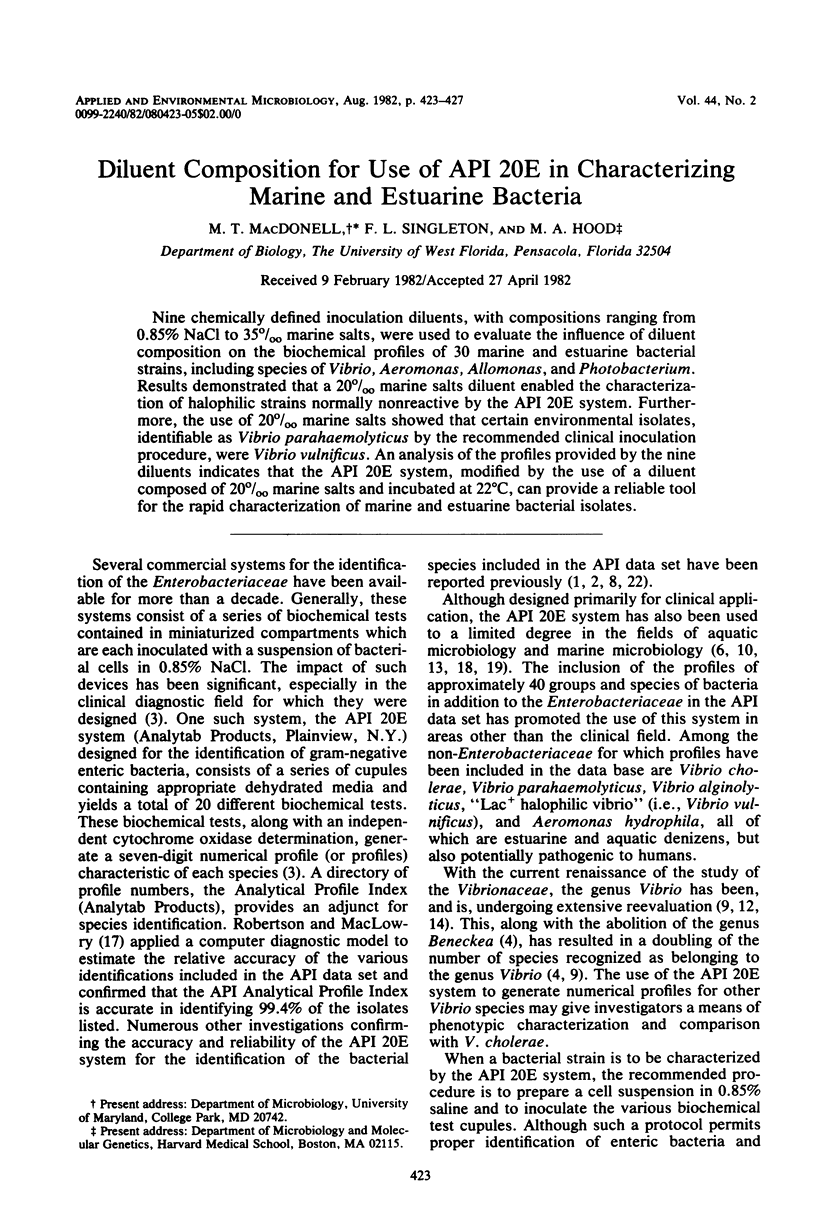
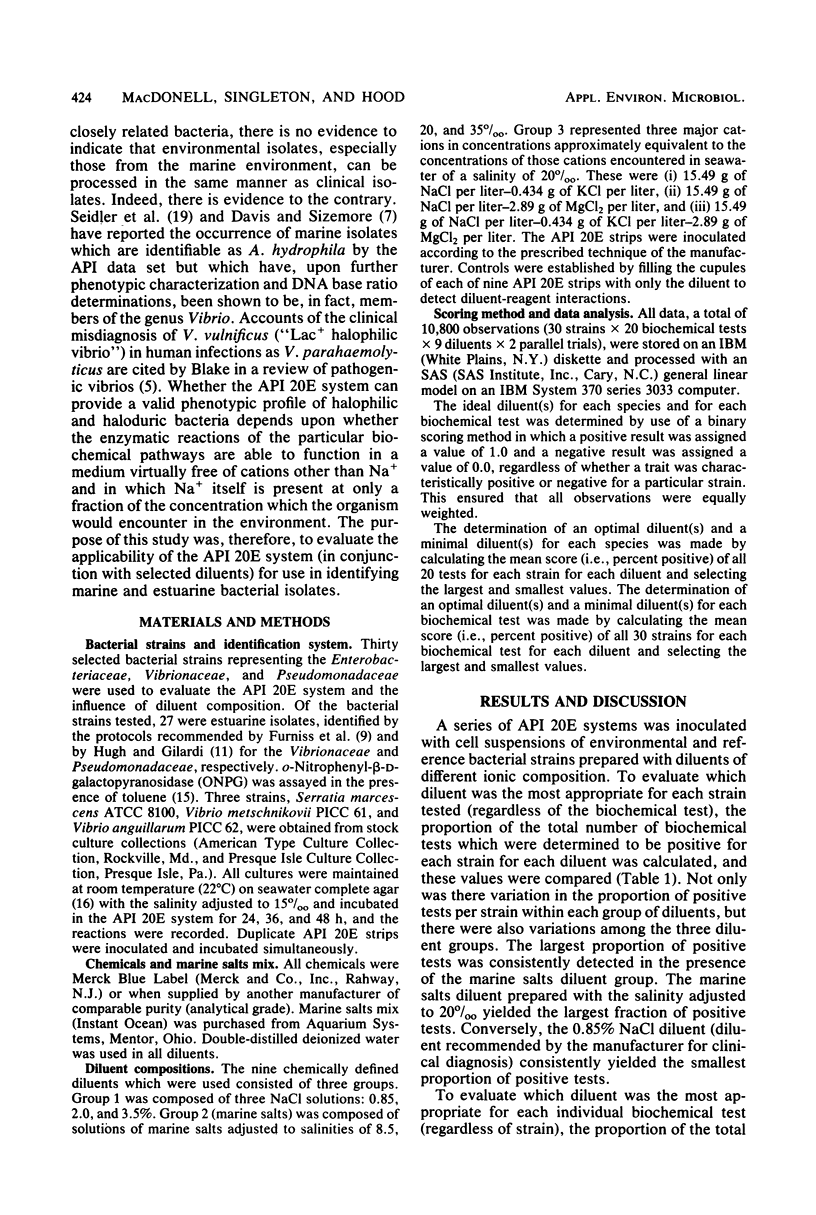
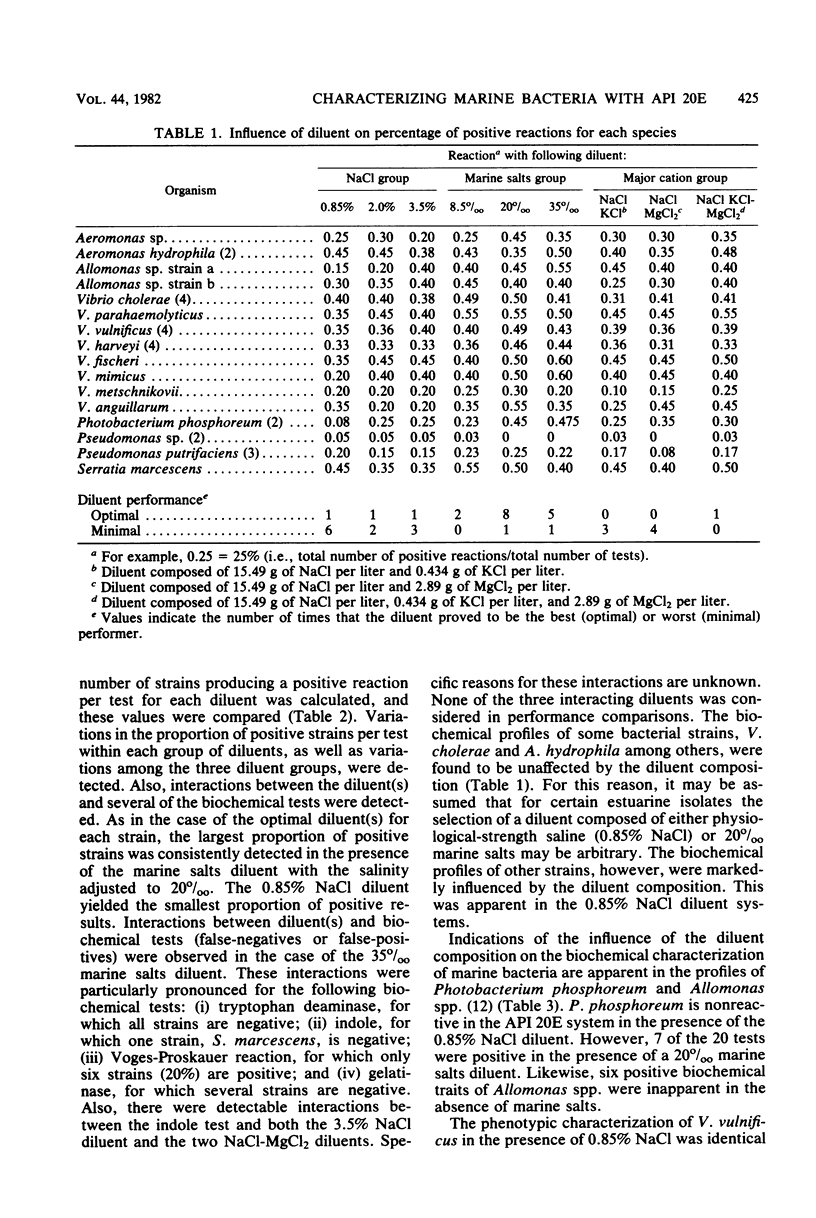
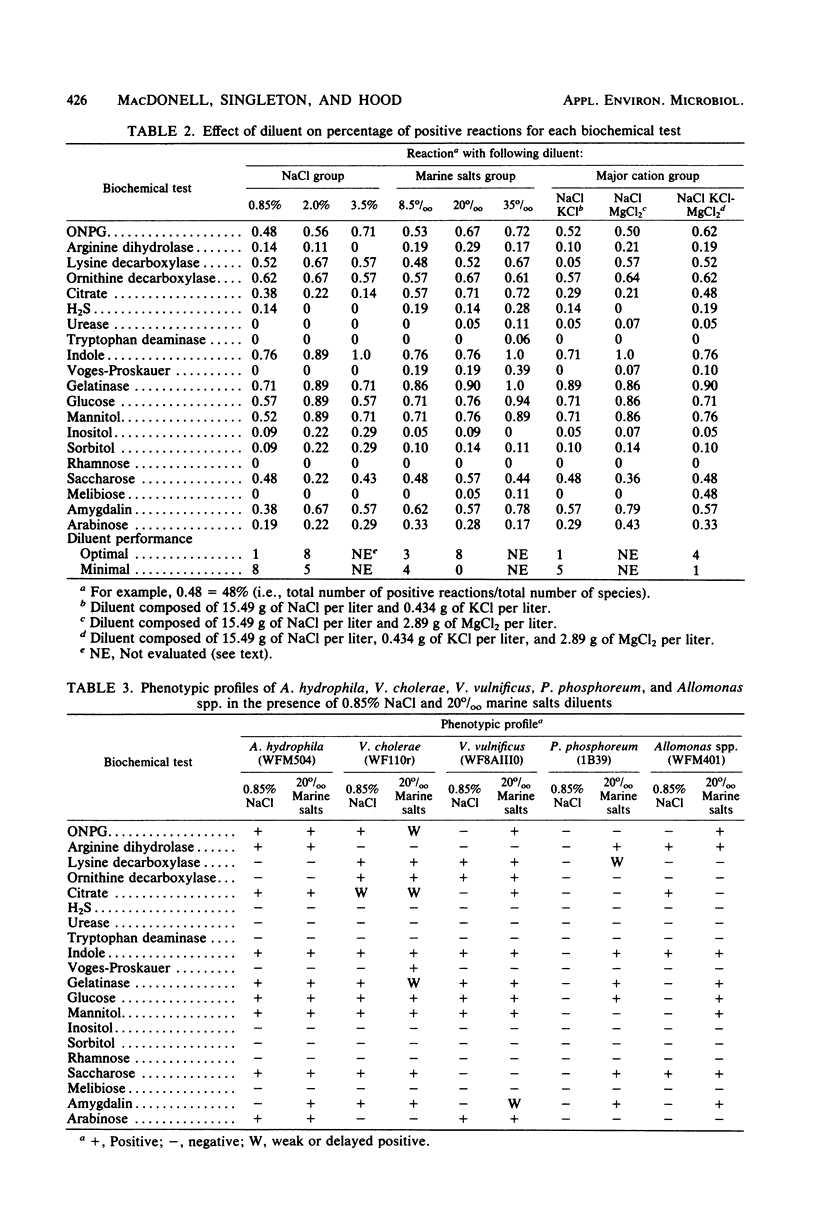
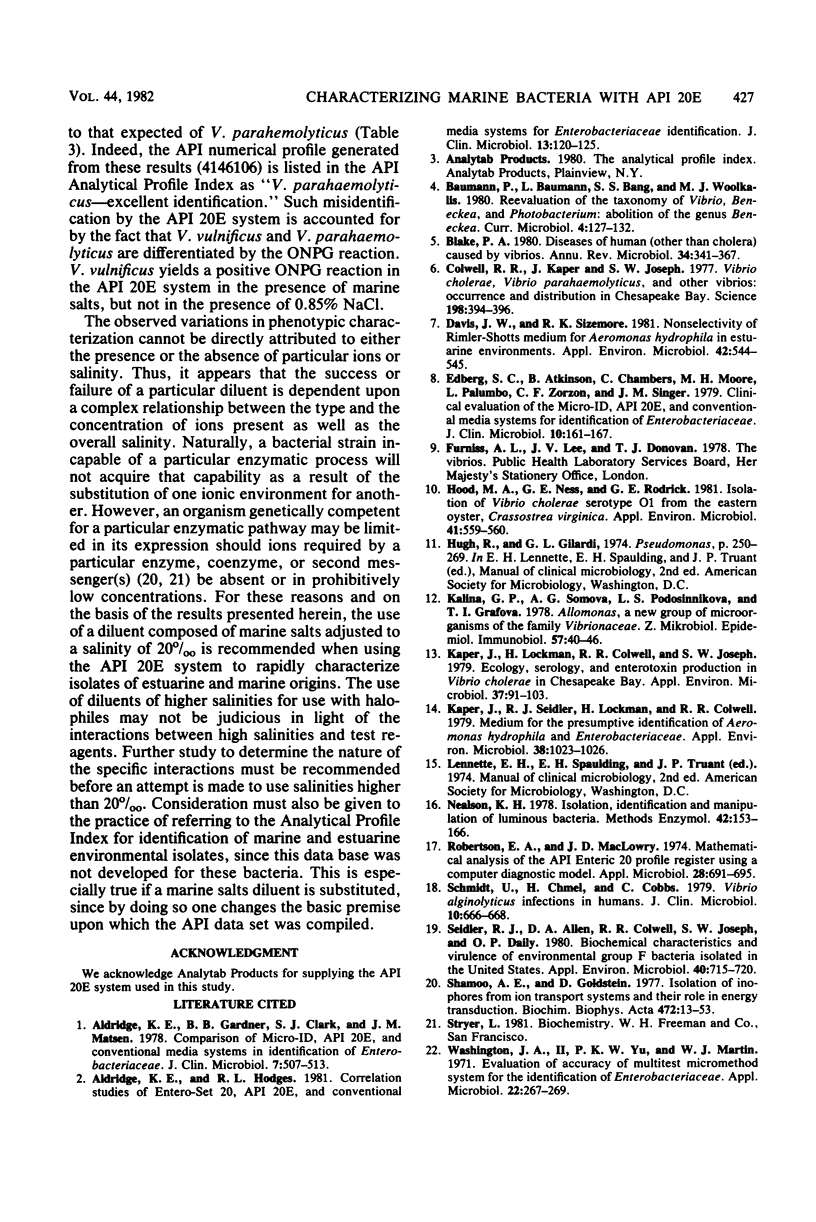
Selected References
These references are in PubMed. This may not be the complete list of references from this article.
- Aldridge K. E., Gardner B. B., Clark S. J., Matsen J. M. Comparison of micro-ID, API 20E, and conventional media systems in identification of Enterobacteriaceae. J Clin Microbiol. 1978 Jun;7(6):507–513. doi: 10.1128/jcm.7.6.507-513.1978. [DOI] [PMC free article] [PubMed] [Google Scholar]
- Aldridge K. E., Hodges R. L. Correlation studies of entero-set 20, API 20E and conventional media systems for Enterobacteriaceae identification. J Clin Microbiol. 1981 Jan;13(1):120–125. doi: 10.1128/jcm.13.1.120-125.1981. [DOI] [PMC free article] [PubMed] [Google Scholar]
- Blake P. A., Weaver R. E., Hollis D. G. Diseases of humans (other than cholera) caused by vibrios. Annu Rev Microbiol. 1980;34:341–367. doi: 10.1146/annurev.mi.34.100180.002013. [DOI] [PubMed] [Google Scholar]
- Colwell R. R., Kaper J., Joseph S. W. Vibrio cholerae, Vibrio parahaemolyticus, and other vibrios: occurrence and distribution in Chesapeake Bay. Science. 1977 Oct 28;198(4315):394–396. [PubMed] [Google Scholar]
- Davis J. W., Sizemore R. K. Nonselectivity of Rimler-Shotts Medium for Aeromonas hydrophila in Estuarine Environments. Appl Environ Microbiol. 1981 Sep;42(3):544–545. doi: 10.1128/aem.42.3.544-545.1981. [DOI] [PMC free article] [PubMed] [Google Scholar]
- Edberg S. C., Atkinson B., Chambers C., Moore M. H., Palumbo L., Zorzon C. F., Singer J. M. Clinical evaluation of the MICRO-ID, API 20E, and conventional media systems for identification of Enterobacteriacea. J Clin Microbiol. 1979 Aug;10(2):161–167. doi: 10.1128/jcm.10.2.161-167.1979. [DOI] [PMC free article] [PubMed] [Google Scholar]
- Hood M. A., Ness G. E., Rodrick G. E. Isolation of Vibrio cholerae serotype O1 from the eastern oyster, Crassostrea virginica. Appl Environ Microbiol. 1981 Feb;41(2):559–560. doi: 10.1128/aem.41.2.559-560.1981. [DOI] [PMC free article] [PubMed] [Google Scholar]
- Kaper J., Lockman H., Colwell R. R., Joseph S. W. Ecology, serology, and enterotoxin production of Vibrio cholerae in Chesapeake Bay. Appl Environ Microbiol. 1979 Jan;37(1):91–103. doi: 10.1128/aem.37.1.91-103.1979. [DOI] [PMC free article] [PubMed] [Google Scholar]
- Kaper J., Seidler R. J., Lockman H., Colwell R. R. Medium for the presumptive identification of Aeromonas hydrophila and Enterobacteriaceae. Appl Environ Microbiol. 1979 Nov;38(5):1023–1026. doi: 10.1128/aem.38.5.1023-1026.1979. [DOI] [PMC free article] [PubMed] [Google Scholar]
- Robertson E. A., MacLowry J. D. Mathematical analysis of the API enteric 20 profile register using a computer diagnostic model. Appl Microbiol. 1974 Oct;28(4):691–695. doi: 10.1128/am.28.4.691-695.1974. [DOI] [PMC free article] [PubMed] [Google Scholar]
- Schmidt U., Chmel H., Cobbs C. Vibrio alginolyticus infections in humans. J Clin Microbiol. 1979 Nov;10(5):666–668. doi: 10.1128/jcm.10.5.666-668.1979. [DOI] [PMC free article] [PubMed] [Google Scholar]
- Seidler R. J., Allen D. A., Colwell R. R., Joseph S. W., Daily O. P. Biochemical characteristics and virulence of environmental group F bacteria isolated in the United States. Appl Environ Microbiol. 1980 Oct;40(4):715–720. doi: 10.1128/aem.40.4.715-720.1980. [DOI] [PMC free article] [PubMed] [Google Scholar]
- Shamoo A. E., Goldstein D. A. Isolation of ionophores from ion transport systems and their role in energy transduction. Biochim Biophys Acta. 1977 May 31;472(1):13–53. doi: 10.1016/0304-4157(77)90013-2. [DOI] [PubMed] [Google Scholar]
- Washington J. A., 2nd, Yu P. K., Martin W. J. Evaluation of accuracy of multitest micromethod system for identification of Enterobacteriaceae. Appl Microbiol. 1971 Sep;22(3):267–269. doi: 10.1128/am.22.3.267-269.1971. [DOI] [PMC free article] [PubMed] [Google Scholar]


